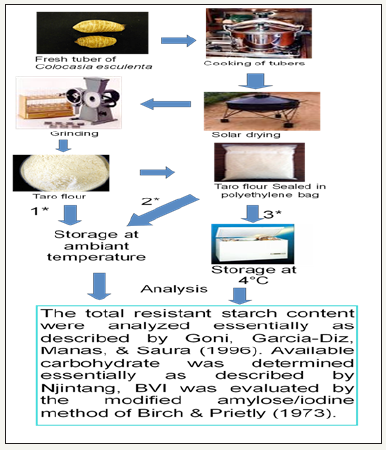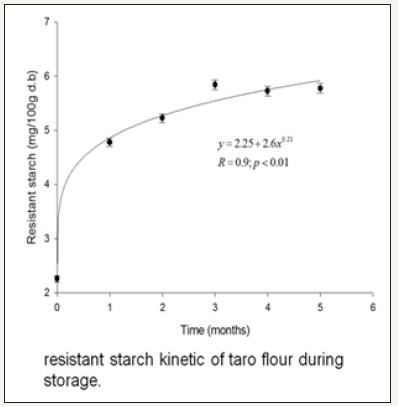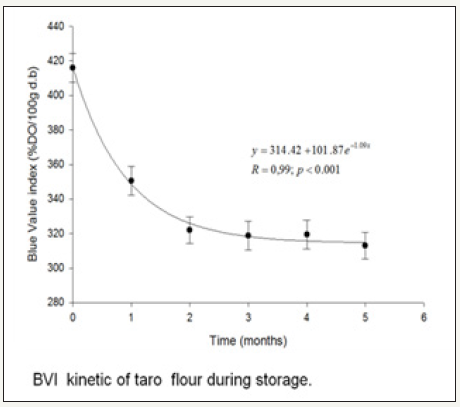- Submissions

Full Text
Annals of Chemical Science Research
Potential Health Benefits in Controlling Type 2 Diabetes of Resistant Starches in Taro (Colocasia Esculenta) Flour Stored During 5 Months
Aboubakar*
Department of renewable energies, Cameroon
*Corresponding author: Aboubakar, Department of renewable energies, Cameroon
Submission: February 04, 2019;Published: February 28, 2019

ISSN : 2688-8394 Volume1 Issue2
Abstract
Non-insulin-dependent or type 2 diabetes mellitus is on the rise in the urban population. The exact cause is unknown. Malnutrition, defective intake of essential fatty acids and reduced intake of fibres are found in urban diet, and dietary factors may be one of the causes leading to increased incidence of the disease. Dietary fibers reduce blood glucose and cholesterol levels. Resistant starches behave as dietary fiber. This study evaluated the potential health benefits in controlling type 2 diabetes of resistant starches in taro (colocasia esculenta) flour stored for 5 months. For this purpose, flour was produced from boiled taro tubers. Cooked tubers were sun dried using a solar dryer, ground through a 500μm sieve and further sieved using 250, 150 and 75μm sieves. Flours were sealed in polyethylene bags and kept at ambient temperature (25 °C) and at 4 °C. One set of flour not sealed was exposed at 25 °C. Flours were stored for 5 months. Resistant starch was quantified directly in the residue obtained after removing digested starch in simulated physiological conditions. Changes in blue index value and soluble sugars of cooked taro were also analysed. The results showed that irrespective of the particle size, the resistant starch significantly increased while BVI and soluble sugar significantly decreased. Significant correlations (R=0.59, p<0.05; R=0.68, p<0.05), were observed between the resistant starch and the BVI and soluble sugar respectively. In fact, the degree of variations of each parameter depends mainly on the storage level.
Keywords: Taro flour; Resistant starch; Storage; Particle size; Diabetes
Introduction
Resistant starch show, potential health benefits which may result in much disease prevention and reduction of sufferings [1]. Among these diseases, type 2 diabetes is one of the most dangerous [2]. This disease is known as a metabolic disorder that is primarily characterized by insulin resistance, relative insulin deficiency and hyperglycemia [3]. Thus, diabetics are recommended to eat a balanced diet containing normal amounts of carbohydrates preferably those with low glycemic index [4]. Taro (Colocasia esculenta) have starches with high glycemic index [5]. But stored during several months, precooked taro flour induced high resistant starch contents [6]. In the context of treatment of non-insulindependent diabetes, breeding for precooked taro flour is of particular interest, as it will be easily incorporated into the dietaryprevention strategy. The objective of this study is the evaluation of the potential health benefits in controlling type 2 diabetes of resistant starches in taro (Colocasia esculenta) flour stored during 5 months in different storage conditions [7].
Materials and Methods
The fresh tubers of Colocasia esculenta were cooked, peeled, sliced and dried in a solar oven. Dried scallops were ground by sifting a hammer mill [8]. The flour obtained was stored in a polyethylene bag at 4 °C a until use Figure 1.
Result and Discussions
The results are tabulated in the above Table 1 and are also shown in the above Figures 2-4. The changes in blue index value and soluble sugars of cooked taro were also analysed. The results showed that irrespective of the particle size, the resistant starch significantly increased while BVI and soluble sugar significantly decreased. Significant correlations (R=0.59, p<0.05; R=0.68, p<0.05), was observed between the resistant starch and the BVI and soluble sugar respectively. In fact, the degree of variations of each parameter depended mainly on the storage level.
Figure 1:

Figure 2:

Figure 3:

Table 1:

Conclusion
Precooked taro flour will play an important role in the dietary management of metabolic disorders such as diabetes.
References
- Hoffmann R (1988) Solids and surfaces: A chemist’s view of bonding in extended structures. Wiley-VCH, Germany.
- Perez E, Schultz FS, De Delahaye EP (2005) Characterization of some properties of starches isolated from Xanthosoma sagittifolium (tannia). Carbohydrate polymers 60(2): 139-145.
- Buttriss JL, Stokes CS (2008) Dietary fiber and health: an overview. Nutrition Bulletin 33 (3): 186-200.
- Liu Q (2005) Understanding starches and their role in food. In: Cui S (Ed.), Food carbohydrates: chemistry, physical properties, and applications. CRC Press/Taylor & Francis Group, New York, USA, pp. 309-349.
- Bruno CH, Colvin JT, Mullarney M P, Zinchuk AV (2003) The relative densities of pharmaceutical powders, blends, dry granulations, and immediate- release tablets. Journal of pharmaceutical technology pp. 64-80.
- Azhar A, Farukh K (2013) Extraction of starch from taro (colocasia esculenta) and evaluating it and further using taro starch as disintegrating agent in tablet formulation with over all evaluation, Inventi Rapid: Novel Excipients, volume 2.
- Keren S, Bianco Peled H, Eyal S (2003) Polymorphism of resistant starch type III. Carbohydrate Polymers 54(3): 363-369.
- Brich GG, Prietly RJ (1973) Degree of gelatinization of cooked rice. Starch 25: 98-100.
- Goni I, Garcia Diz L, Manas E, Saura Calixto F (1996) Analysis of resistant starch: a method for foods and food products. Food Chemistry 56(4): 445-449.
© 2019 Aboubakar. This is an open access article distributed under the terms of the Creative Commons Attribution License , which permits unrestricted use, distribution, and build upon your work non-commercially.
 a Creative Commons Attribution 4.0 International License. Based on a work at www.crimsonpublishers.com.
Best viewed in
a Creative Commons Attribution 4.0 International License. Based on a work at www.crimsonpublishers.com.
Best viewed in 







.jpg)






























 Editorial Board Registrations
Editorial Board Registrations Submit your Article
Submit your Article Refer a Friend
Refer a Friend Advertise With Us
Advertise With Us
.jpg)






.jpg)














.bmp)
.jpg)
.png)
.jpg)










.jpg)






.png)

.png)



.png)






